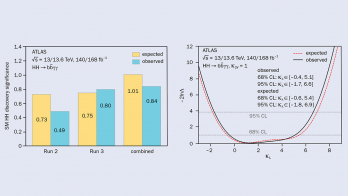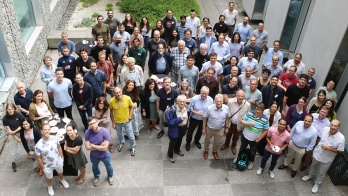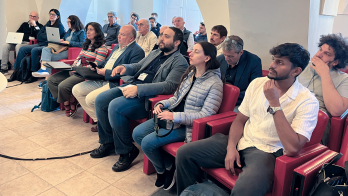
Measuring the production of the top quark with vector bosons can provide fresh insight into the Standard Model (SM), in particular by testing the top quark and heavy vector boson vertices, which may be modified by extensions to the SM. In two new results, ATLAS presents strong evidence for the production of a single top quark in association with a Z boson (tZ) and has for the first time extracted differential cross-sections for the production of a top quark in association with a W boson (tW). While tW production was already measured during LHC Run 1, the next in line, the tZ process, is much harder to observe because its production rate is about one hundredth lower.
For both the tZ and tW processes, separating them from background events is critical. ATLAS searched for events containing leptons (electrons or muons), jets and transverse momentum imbalance. All the information from the measured particles is condensed into one multivariate discriminator (MVA) trained to separate the signal from the background.
The new ATLAS results use data collected in 2015 and 2016, corresponding to an integrated luminosity of 36.1 fb–1. For the tZ analysis, 25 signal events are found after selection, together with 120 background events. Applying the MVA allows the signal and background to be better separated (see figure, left), leading to a signal significance of 4.2 standard deviations. This constitutes strong evidence that the associated production of a single top quark and a Z boson has been seen, and the observed production rate agrees with that predicted by the SM.
The extraction of differential cross-sections for tW is particularly challenging, as top quarks almost always decay into a b quark and a W boson, leaving two W bosons in the final state. The dominant background from the production of a top quark with a top antiquark has an 11 times larger inclusive production rate. Applying the MVA it is possible to select events with a signal to background ratio of about 1:2, which allows the signal cross-section to be extracted as a function of kinematic observables. Differential cross-sections have been measured as a function of several variables and measured and compared to predictions implemented in different Monte Carlo programmes (see figure). The uncertainty on the measurements is at the 20–50% level, dominated by statistical effects. While the analysis was not able to exclude particular models, the data tend to have more events with high-momentum particles than predicted.
With the additional data to be collected over the next years, ATLAS will study both tW and tZ production in more detail, and improve its searches for the even rarer and more elusive production of a (single) top quark in association with a Higgs boson.
Further reading
ATLAS Collaboration 2017 arXiv:1712.01602.
ATLAS Collaboration 2017 arXiv:1712.03659.







